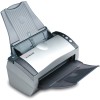Xerox XDM2625D-WU User Manual - Page 53
Storage and CD-R/W, Fax and Print
 |
View all Xerox XDM2625D-WU manuals
Add to My Manuals
Save this manual to your list of manuals |
Page 53 highlights
Scanning 48 • Text Editors include Microsoft Word and WordPad, Microsoft Excel, and other word processing and spreadsheet applications. Select this option if you want OCR processing to convert your scanned documents to text that you can edit. See "Scanning with Optical Character Recognition (OCR)" on page 65 for more about OCR. • PDF applications are for documents scanned to the PDF format. • Email includes Microsoft Outlook and other email applications. See "eMail Properties" on page 40 for details about attaching scanned documents to your email messages. • Storage and CD-R/W is for either storing scanned documents in a folder, or sending them to a CD burner to create a CD containing the scanned documents. See "Transferring Scanned Documents to Storage" on page 75 and "Scan and Burn to a CD" on page 69 for details. • Fax and Print is for sending your scanned documents directly to your printer or fax software for faxing. • Sti event forwarding is for using another application's interface for scanning. The One Touch Event Forwarding dialog box opens so you can select which application to use to continue scanning. See "Scanning with Event Forwarding" on page 71 for details. 4. After selecting a new category for the Destination Applications, click the Multi Function tab to see which ones are added to the list. Show Progress Window-Select this option to display the progress window of the document(s) during scanning. Use enhanced folder browser-Select this option if you want to save your scans to a network location that is not a mapped drive on your computer. Create copies of scanned documents-Sometimes the image of a scanned document is only saved as a temporary file until its Destination Application is finished using it. In those cases you may or may not want an additional, permanent copy saved on your hard drive. For example, if you scan a picture to an email application, the scanned image is saved as a temporary file, then attached to the email, and the email is sent. Later, the temporary file of the scanned picture is deleted. The same situation may occur when you scan directly to a printer or scan to a fax application. After a scanned item is printed or faxed, its temporary file is deleted. However, by selecting this Create copies of scanned documents option, you can choose to save permanent copies of the scanned items on your hard drive. DocuMate 262 Scanner User's Guide















